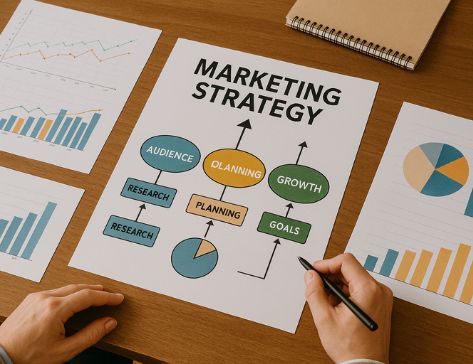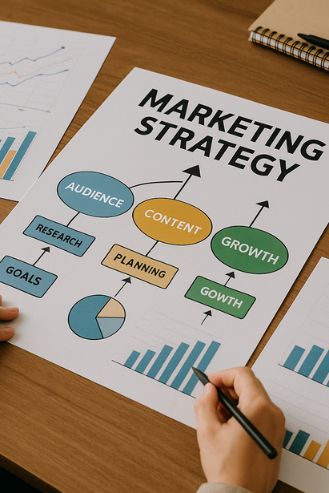
The Power of Marketing Strategy: A Complete Guide to Planning, Execution, and Growth
Marketing strategy is the compass that aligns your brand, your resources, and your market opportunities so every campaign, message, and dollar moves you closer to measurable growth.
Put simply, a marketing strategy is your long-term plan for winning in the market—who you serve, why you win, and how you prioritize channels, messages, and budgets. It brings discipline and focus to execution, prevents random acts of marketing, and clarifies what to measure. If you have ever wondered why every business needs one, the answer is that strategy saves time, money, and momentum by turning scattered tactics into coordinated impact.
A strong strategy starts with a clear business objective (revenue, market share, product adoption, retention) and a sharp definition of your ideal customer profile. From there, it connects positioning, messaging, and channels into a coherent plan that sales, product, and marketing can execute together. The payoff is not just more leads or followers—it is predictable pipeline, stronger pricing power, and brand preference that compounds.
Before you race to tactics, step back and build a durable foundation. The sections below provide a practical, step-by-step framework you can apply immediately. For additional depth, you may explore this excellent step‑by‑step guide that complements the blueprint here.

What a Good Marketing Strategy Includes
- Business objectives: A small set of measurable goals mapped to company priorities.
- Segmentation and ICP: Defined audiences with firmographics, behaviors, and pains you can solve.
- Positioning and messaging: Why you are different, and the messages that prove it.
- Channel strategy: How you reach and convert audiences across paid, owned, and earned media.
- Resource and budget plan: People, tools, and dollars allocated by priority and expected ROI.
- Roadmap and calendar: Sequenced initiatives, with quarterly themes and weekly deliverables.
- Measurement: A dashboard of leading and lagging indicators tied to objectives.
Step-by-Step Framework to Build Your Marketing Strategy
- Clarify the business goal. Choose one or two primary objectives (e.g., new ARR, activation, retention). Write them in SMART format and set a baseline.
- Define and prioritize segments. Build a crisp Ideal Customer Profile. Include decision makers, buying triggers, and objections. Rank segments by strategic value and ease of win.
- Craft positioning and messaging. Use a value pyramid: Outcome (top), Capabilities (middle), Proof (base). Convert objections into proof points and social evidence.
- Choose channels by job-to-be-done. Map channels to funnel stages: discovery (PR, social, SEO), evaluation (content, webinars), conversion (retargeting, sales enablement), and expansion (email, communities).
- Design your offers and content. Align lead magnets and product-led experiences to pain points. Use content clusters around the focus keyword and its variants to compound SEO.
- Build a quarterly roadmap. Pick themes, then define the 3–5 needle-moving initiatives per quarter. Sequence launches and campaigns to avoid internal conflicts.
- Set budgets and resourcing. Allocate by channel effectiveness and learning agenda. Protect 10–20% of budget for experiments.
- Instrument measurement. Define a minimal dashboard: traffic quality, MQL→SQL rates, pipeline created, CAC, payback, and LTV/CAC. Add cohort views for retention.
- Run the operating cadence. Weekly standups, monthly reviews, and quarterly retros ensure you learn faster than competitors.
Practical Tips for Smarter Execution
Use a Message Map
Center your narrative on one core promise, three supporting pillars, and proof points for each pillar. This keeps ads, landing pages, and sales decks consistent.
Adopt a Content Cluster Strategy
Create a definitive pillar page for your focus keyword and publish 8–12 supporting articles that interlink naturally. This builds topical authority and improves rankings.
Balance Near-Term and Compounding Channels
Mix paid demand (fast, expensive) with organic engines (slow, compounding). Establish clear success metrics and ramp/retreat rules for each channel.
Channel Selection: How to Choose What Works for You
Start where your buyers already spend attention. For B2B, consider LinkedIn, targeted search, partner co-marketing, and webinars. For B2C, evaluate paid social, creators, and lifecycle email/SMS. In both cases, drive all traffic to fast, focused landing pages with a single, unmissable call to action.
Score channels on four factors: audience fit, intent level, cost to test, and speed to insight. Pick two primary channels, one secondary, and one long-term bet. Design tests that answer a specific question within two weeks and under a modest budget cap.
Measurement: From Vanity to Value
Leading Indicators
- Qualified traffic and engaged sessions
- Content-assisted conversions
- MQL to SQL conversion rate
Lagging Indicators
- Pipeline and revenue sourced
- CAC, payback period
- LTV/CAC and net revenue retention
Quality Checks
- Sales cycle length vs. baseline
- Opportunity win rate by segment
- Churn reasons linked to positioning gaps
Common Pitfalls to Avoid
- Confusing tactics for strategy: Ads and posts are not a strategy; they are execution. Start with positioning and ICP.
- Chasing every channel: Spread too thin and you learn nothing. Concentrate on a few channels and iterate.
- Measuring everything, learning nothing: Pick a focused dashboard that reflects funnel health, not vanity metrics.
- Inconsistent messaging: If sales and marketing say different things, deals stall. Use shared enablement materials.
Templates You Can Adapt Fast
One-Page Strategy
- Goal: e.g., $2M pipeline in Q2
- ICP: Segment, triggers, decision makers
- Positioning: Promise, pillars, proof
- Channels: Primary, secondary, long-term bet
- Offers: Lead magnet, product trial, event
- KPIs: Leading and lagging metrics
- Risks: Assumptions and mitigation
90-Day Execution Plan
- Weeks 1–2: Finalize ICP, message map, and first offers
- Weeks 3–6: Launch two channel tests and a pillar page
- Weeks 7–8: Double down on the winner; ship 4 supporting articles
- Weeks 9–12: Add a webinar or partner activation; optimize landing pages
FAQ: Quick Answers
How often should a marketing strategy change?
Revisit quarterly to incorporate learnings, update assumptions, and adjust budgets. Do not pivot core positioning without clear market signals.
What is the difference between marketing strategy and GTM?
Strategy is the enduring plan to win; go-to-market is how you operationalize launches and revenue motions within that strategy.
How long before results show up?
PPC and outbound can move within weeks; organic content, SEO, and community may take 3–6 months but compound more powerfully over time.
Conclusion
A focused marketing strategy turns uncertainty into speed, and activity into outcomes. Start with the business goal, anchor on the customer, articulate a clear promise, and concentrate your effort on the channels most likely to move the metric that matters. Test fast, measure what counts, and keep your message consistent from ad to demo to onboarding. When you are ready to scale creative testing or competitive research, a platform like Anstrex can help you find and validate angles more efficiently. Pick a place to start this week, write down your assumptions, and begin your first two experiments—momentum compounds.


